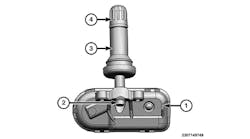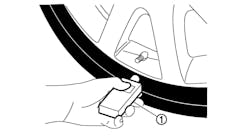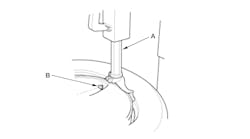DESCRIPTION & OPERATION
The tire pressure monitor system warns the driver when a significant loss of tire pressure occurs in any of the equipped tires. It allows the driver to display the individual tire pressures and their locations on the driver information center. When the vehicle is stationary, the sensor's internal shock sensor is inactive which puts the sensors into a Stationary state. In this state the sensors sample tire pressure once every 30 seconds and do not transmit if the tire pressure does not change. As vehicle speed increases, the shock sensor pulses every wheel rotation, which puts the sensor into Rolling mode. The remote control door lock receiver receives and then sends the tire pressure and temperature data to the body control module (BCM). The BCM translates the data contained in the tire pressure sensor radio frequency transmissions into sensor presence, sensor mode and tire pressure. Once the vehicle speed is greater than 25 mph, the sensors begin to transmit once a minute keeping the pressure data up to date.
Each sensor has its own unique identification (ID) code which it transmits as part of each RF message and must be learned into the BCM memory. Once all four IDs have been learned and vehicle speed is greater than 25 mph, the BCM continuously compares IDs and pressure data in the received transmissions to the learned IDs and pressures to determine if all four sensors are present and if one or more tires are low. If the BCM detects a low tire pressure condition, or a malfunction in the system, it will send a serial data message to the instrument cluster requesting the appropriate tire pressure monitor indicator illumination and also to display the appropriate data message on the driver information center, if equipped.
TIRE PRESSURE INDICATOR SENSOR LEARN
Tire Pressure Sensor Learn with EL-52545 (preferred)
The EL-52545 allows the tire pressure sensors to be learned without transmitting RF data between the tire pressure sensors and the vehicle. When using the EL-52545, each tire pressure sensor ID is learned and stored internally. The EL-52545 is then connected to the vehicle DLC using the OBD2 Interface Module, which is part of the EL-52545 kit. The stored tire pressure sensor information then will be loaded into the K9 Body Control Module. Using the EL-52545 to learn tire pressure sensors will prevent the vehicle from learning an errant nearby tire pressure sensor from other vehicles in a service facility environment, especially if the tire pressure sensor batteries are low. This is the GM recommended method to learn tire pressure sensors.
1. Turn on EL-52545.
2. Select RDR from the on-screen display.
Make sure the TPMS tool battery is sufficient to complete the learn process. Do not place the TPMS tool directly on the valve stem. The tool should be placed against the tire sidewall near the valve stem. The sensor learn activation procedure may have to be repeated up to three times before determining if a sensor is malfunctioning.
3. If available, scan the QR code on the vehicle's tire placard or certification label. If a QR is not available, select MMY from the on-screen display and manually input the vehicle information.
4. Approach the vehicle starting with the left front tire and read each tire pressure sensor information by pressing the green trigger button with the EL-52545 located near the tire valve stem. Read each tire pressure sensor in the order identified on the EL-52545 .
If any sensors display "Sensor Not Compatible" on the EL-52545 screen, you will need to first make sure compatible sensors are installed on the vehicle.
5. If any tire pressure sensors do not respond, replace the tire pressure sensor only after several attempts have been made to identify all sensors. An undetected sensor will be identified with "No Sensor Detected" displayed in the table. After sensor replacement rerun RDR procedure.
6. Verify the BAT value for each tire pressure sensor in the table on the EL-52545 is OK. If the value is not OK, replace the tire pressure sensor and rerun RDR procedure.
7. Verify the pressure and temperature values are reasonable based on the ambient conditions and actual tire pressure. If either value is inaccurate, replace the tire pressure sensor and rerun RDR procedure.
8. Ignition On/Vehicle in Service Mode.
9. Connect the EL-52545 OBD2 Interface Module to the EL-52545 .
10. Verify the OBDII icon is displayed on the EL-52545 and the green com LED is flashing on the EL-52545 OBD2 Interface Module.
11. Connect the other end of the OBD2 Interface Module to the vehicle DLC.
12. Select OK on the EL-52545 and follow the on-screen instructions.
Tire Pressure Sensor Learn with EL-50448 (alternative)
When EL-50448 Tire Pressure Monitor Sensor Activation Tool is used in activate mode, it produces a low frequency transmission that activates the sensor. The sensor responds to a low frequency activation by transmitting in Learn Mode-Remotely Triggered. When the BCM receives a learn mode transmission while in Learn mode, it will assign that sensor's ID to the location on the vehicle relative to the order in which it was learned.
In the event a particular sensor is activated and the horn does not chirp, it may be necessary to rotate the wheel so that the valve stem is in a different position, because the sensor signal is being blocked by another component.
1. Ignition On/Vehicle in Service Mode, using driver information center buttons or scan tool (if available), initiate the Tire Pressure Sensors Learn mode. A double horn chirp will sound indicating the Learn mode has been enabled. The left front turn signal will also be illuminated.
2. Starting with the left front tire, activate the sensor by holding the antenna of the tire pressure monitor activation tool aimed upward against the tire sidewall close to the wheel rim at the valve stem location. Press and release the activate button. Ensure the transmit indicator on the special tool indicates the sensor activation signal is being transmitted. Wait for a horn chirp. If the horn does not chirp, repeat the sensor activation sequence with the tool. Once the horn chirp has sounded, the sensor information is learned and the turn signal in the next location to be learned will illuminate.
3. After the horn chirp has sounded and the right front turn signal is illuminated, repeat the previous step for the remaining sensors in the following order: Right front / Right rear / Left rear.
4. When the left rear sensor has been learned and a double horn chirp has sounded, the learn process is complete and the BCM exits Learn mode.
TIRE DEMOUNTING AND MOUNTING
Demounting Procedure
1. Raise and support the vehicle.
2. Remove the tire and wheel assembly.
3. Remove the valve core and release the air pressure.
4. Deflate the tire completely.
5. Use the tire changing machine to remove the tire from the wheel following the manufacturer specific directions for the tire changing machine being used. (Center-Clamp tire changers are recommended.)
Failure to position valve stem in proper position while dismounting and mounting the tire may result in the TPM sensor to become damaged.
6. When separating the tire bead from the wheel, do not allow the bead breaker to contact the valve stem/TPMS sensor as they will be damaged.
7. Position the tire machine removal head to the outer tire bead so it will operate without contacting the valve stem/TPMS sensor.
8. Using the tire changing machine, remove the outer tire bead from the wheel.
9. Position the tire machine removal head to the outer tire bead so as it will operate without contacting the valve stem/TPMS sensor.
10. Using the tire changing machine, remove the inner tire bead from the wheel and remove the tire.
11. If a tire sealant product was used/found within the tire, and the tire is repairable, use a mild dish soap, clean water and shop cloths to remove the sealant residue. (Refer to information on the tire sealant Material Safety Data Sheet and follow guidelines for handling and disposal.)
12. If a confirmed GM approved tire sealant product has been used/found within the tire, use a mild dish soap, clean water and shop cloths to remove the sealant residue from the tire pressure indicator sensor.
13. If a tire sealant product was used/found within the tire, and it cannot be confirmed that a GM approved product was used, replace the tire pressure indicator sensor.
14. Use medium coarseness steel wool to remove any rubber or corrosion from the wheel bead seats.
15. Inspect the tire and wheel for any damage, replace as necessary.
Mounting Procedure
When mounting the tires, use an approved tire mounting lubricant. Do not use silicon or corrosive base compounds to lubricate the tire bead and the wheel rim. A silicon base compound can cause the tire to slip on the rim. A corrosive type compound can cause tire or rim deterioration.
1. Apply mounting lubricant to the tire bead and the wheel.
2. Use the tire changing machine to install the tire to the wheel following the manufacturer directions for the tire changing machine being used. (Center-Clamp tire changers are recommended.)
3) Place the inner tire bead onto the wheel.
Failure to position the valve stem in proper position while demounting and mounting the tire may result in the TPMS sensor becoming damaged.
4. Position the tire machine installation head to the inner tire bead so as it will operate without contacting the valve stem/TPMS sensor.
5. Using the tire changing machine, install the inner tire bead to the wheel.
6. Position the tire machine installation head to the outer tire bead so as it will operate without contacting the valve stem/TPMS sensor.
7. Using the tire changing machine, install the outer tire bead to the wheel.
To avoid serious personal injury, do not stand over tire when inflating. The bead may break when the bead snaps over the safety hump. Do not exceed 40 psi pressure when inflating any tire if the beads are not seated. If 40 psi pressure will not seat the beads, deflate, relubricate the beads and reinflate. Overinflation may cause the bead to break and cause serious personal injury.
8. Some run-flat tires may require more than 40 psi to seat the bead. In such a case, a tire safety cage must be used. Consult the tire manufacturer for its individual repair policy.
9. Inflate the tire until it passes the bead humps. Be sure that the valve core is not installed at this time.
10. Install the valve core to the valve core stem.
11. Inflate the tire to the specified pressure as stated on the tire placard.
12. Balance the tire and wheel assembly.
13. Install the tire and wheel assembly.
14. Remove the support and lower the vehicle.
TIRE PRESSURE SENSOR REMOVAL AND INSTALLATION
Removal Procedure
1. Raise and support the vehicle.
2. Remove the tire and wheel assembly.
3. Demount the tire from the rim.
4. Insert an anti rotation pin through the cross-drilled hole in the valve stem.
5. Hold the valve stem to prevent it from rotating, then remove and discard the bolt from the tire pressure indicator sensor.
6. Pull the tire pressure indicator sensor straight off the valve stem. Do not twist the tire pressure indicator sensor to remove.
7. Cut the inner seal off the valve stem.
Do not scratch or damage the clear coating on aluminum wheels with the tire changing equipment. Scratching the clear coating could cause the aluminum wheel to corrode and the clear coating to peel from the wheel.
8. Remove and discard the valve stem by pulling it through the rim using a valve stem removal tool.
9. Clean all sealing surfaces
Installation Procedure
The tire pressure indicator sensor is supplied assembled to a NEW valve stem. They must be separated before installation.
1. Remove the new bolt from the tire pressure indicator sensor and pull it straight off the new valve stem.
2. Apply lubricant to the new valve stem. (Valve stems and bolts are single use items.)
3. Using a tire pressure valve stem mounting tool, pull the valve stem through in a direction parallel to the valve hole on the rim.
Ensure the flat surfaces of the tire pressure indicator sensor and the tire pressure valve stem are located correctly.
Rotate the valve stem by hand to align the tire pressure indicator sensor.
Do not tighten the bolt at this stage.
5. Assemble the tire pressure indicator sensor to the valve stem and install the new bolt hand tight.
6. Insert an anti rotation pin through the cross-drilled hole in the valve stem.
7. Hold the valve stem to prevent it from rotating and tighten the bolt to 1.4 N.m (12.4 lb in).
8. Check the valve stem to ensure that it is fully seated on the rim as follows:
- The rim hole edge has to be completely in the notch of the valve stem.
- The valve and the rim hole have to be concentric.
9. Make sure there is a parallel gap between the valve stem and the tire pressure indicator sensor. The tire pressure indicator sensor must NOT be in contact with the wheel.
10. When correctly positioned there will be a parallel gap between the tire pressure indicator sensor and the wheel.
NOTE: Tire pressure indicator sensors are shipped in the OFF mode. The sensor will exit its OFF state when the tire is inflated. Also, the tire should not have contact with the tire pressure indicator sensor during installation to prevent damage to the sensor.
11. Mount the tire to the rim. Install the tire and wheel assembly, and remove the support and lower the vehicle.
12. Perform the tire pressure indicator sensor learn procedure.
TORQUE SPECIFICATIONS
Single Use Threaded Fastener/Component Tightening Specifications
Tire Pressure Indicator Sensor Bolt: 1.4 N.m (12.4 lb in)
Reusable Threaded Fastener Tightening Specifications
Wheel Nut: 140 N.m (103 lb ft)




